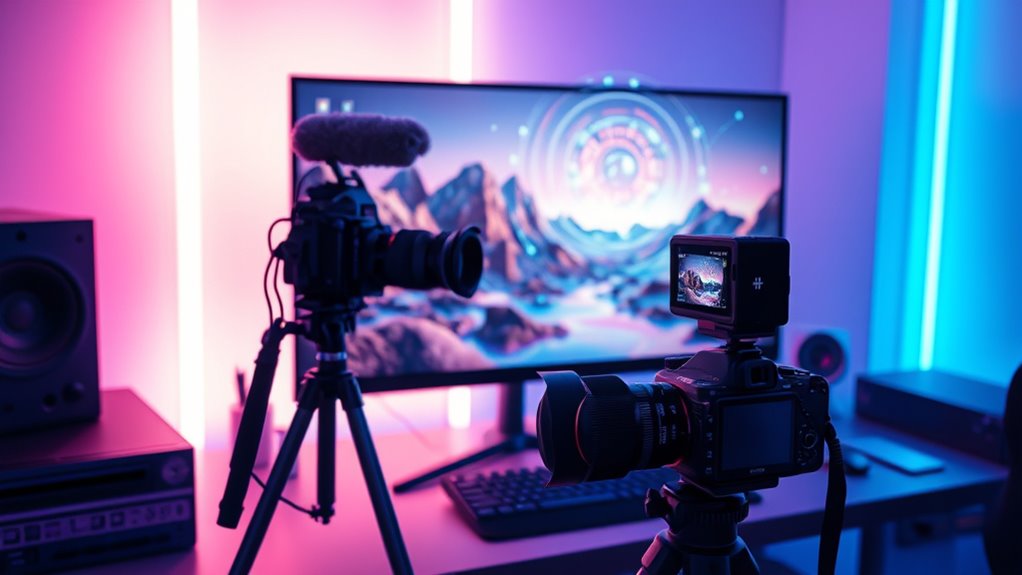Generative AI in Photos and Video: What’s Possible

Generative AI now lets you create highly realistic images and videos, including lifelike portraits of people who don’t exist. It can also seamlessly manipulate videos through deepfake technology, enabling face swaps, voice synthesis, and scene changes. These tools open up new creative and marketing possibilities, but come with risks like misinformation. As these technologies continue evolving, you’ll discover even more ways they transform visual content and how responsible use is key to harnessing their potential.
Key Takeaways
- AI can generate highly realistic images and portraits of non-existent people, reducing the need for traditional photoshoots.
- Deepfake technology enables seamless face swapping and realistic video synthesis, creating convincing manipulated videos.
- AI-driven tools facilitate rapid creation of complex visual content for advertising, entertainment, and personal projects.
- Ethical concerns include misinformation, identity theft, and reputation damage due to malicious AI-generated media.
- Ongoing advancements aim to improve detection methods, ensuring responsible use and maintaining trust in visual content.

Generative AI is revolutionizing the way we create and manipulate photos and videos, making it easier than ever to produce realistic images and compelling visual content. With AI-generated portraits, you can craft lifelike images of people who don’t exist, opening new doors for creative projects, advertising, and entertainment. These portraits are so convincing that distinguishing them from real photographs can be challenging, showcasing just how advanced AI technology has become. Deepfake technology, a subset of generative AI, takes this further by seamlessly replacing faces in videos or synthesizing entirely new ones, allowing you to create realistic videos of people saying or doing things they never actually did.
As you explore AI-generated portraits, you’ll notice how quickly you can generate complex, detailed images with just a few prompts. This means you no longer need extensive photography sessions or professional models to get high-quality visuals. Instead, AI models analyze vast datasets to produce new images that fit your specifications, whether for marketing, storytelling, or personal projects. The realism achieved in these portraits can be astonishing, making them suitable for a variety of applications where authenticity matters.
Deepfake technology amplifies these possibilities by enabling you to manipulate existing videos or create entirely new ones. For instance, you might use deepfakes to bring historical figures back to life, generate celebrity endorsements without their direct involvement, or produce realistic training videos for healthcare or safety. However, this power comes with responsibility. Deepfakes can be misused to spread misinformation, impersonate individuals, or create harmful content. You need to approach this technology ethically, ensuring it’s used for positive and legitimate purposes.
As you explore generative AI in videos and photos, you’ll find that the line between reality and virtual creations continues to blur. While this opens exciting opportunities for innovation, it also raises questions about authenticity and trust. It is vital to verify the origin of visual content and remain cautious of manipulated media. With the rapid advancements in AI-generated portraits and deepfake technology, you can expect even more sophisticated tools to emerge, making it necessary to stay informed and responsible in your use of these powerful tools. Ultimately, generative AI is transforming how we create visual content, giving you unparalleled creative control—just remember to wield it wisely. Additionally, ongoing advancements in AI detection methods help to combat malicious use and ensure ethical standards are maintained in the industry.
Frequently Asked Questions
How Does Generative AI Handle Copyright Issues in Media Creation?
You should know that generative AI addresses copyright dilemmas by incorporating licensing challenges into its design, often using licensed data to train models. Developers aim to prevent unauthorized content creation, but legal uncertainties still exist. When creating media, you must stay aware of these issues, ensuring you respect existing copyrights and licensing rules. This way, you can avoid potential legal problems while leveraging AI’s creative power responsibly.
What Are the Ethical Concerns Surrounding Ai-Generated Photos and Videos?
You might worry about privacy concerns and misinformation risks with AI-generated photos and videos. Ethically, you could struggle with consent, as deepfakes can manipulate reality or infringe on individuals’ rights. While AI offers creative potential, it also raises questions about authenticity and trust. You must consider how these tools can be misused and guarantee responsible use to protect privacy and prevent spreading false information.
Can Generative AI Accurately Replicate Real People’s Appearances?
You might wonder if generative AI can accurately replicate real people’s appearances. It often creates highly convincing images, but deepfake detection tools and facial recognition tech can sometimes expose these fakes. While AI can mimic features closely, subtle inconsistencies may reveal the artificial nature. Always stay cautious, especially with sensitive content, and use advanced detection methods to verify authenticity.
How Accessible Are These AI Tools for Amateur Content Creators?
You’ll find that AI tools are increasingly user-friendly and affordable for amateurs. Many platforms offer intuitive interfaces, making it easy for you to create stunning photos and videos without prior experience. These tools often come at a low cost or even free, giving you access to powerful features. So, whether you’re just starting out or experimenting, generative AI is accessible and ready to help you produce professional-looking content effortlessly.
What Future Advancements Are Expected in Ai-Generated Visual Media?
You can expect future advancements like more sophisticated neural style transfer and seamless video synthesis, making visual media even more realistic and customizable. These innovations will allow you to easily create artistic effects or generate entire videos from simple sketches or descriptions. As technology improves, you’ll find it easier to produce high-quality content quickly, opening new creative possibilities and transforming how amateurs like you craft and share visual stories.
Conclusion
You might be surprised to learn that over 70% of creative professionals now use generative AI for photos and videos, transforming how content is made. As this technology advances, your possibilities expand—from creating hyper-realistic images to deepfake videos. With AI’s rapid growth, you’ll want to stay informed about its potential and pitfalls. Embrace these innovations now, and you’ll be ahead in shaping the future of visual storytelling. The possibilities are truly endless, so don’t miss out!

